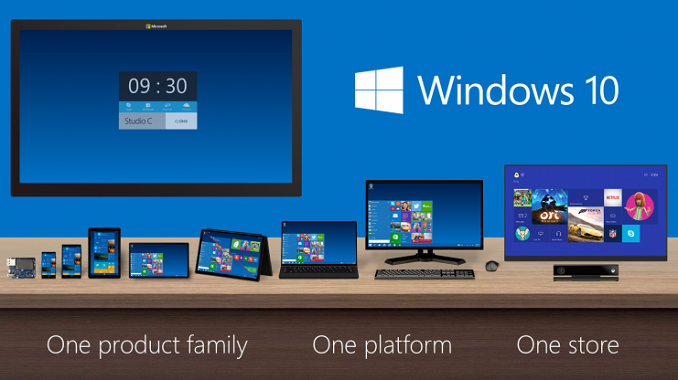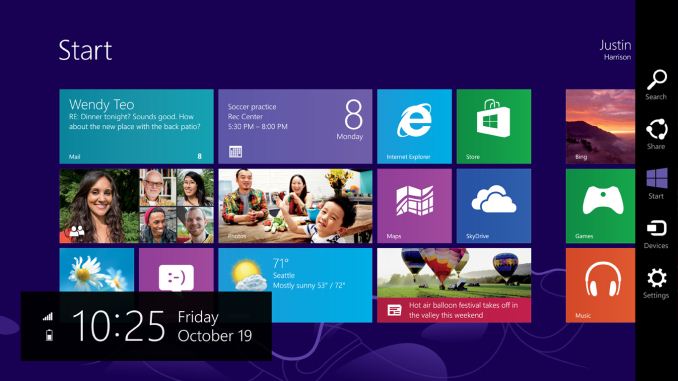Windows 10 Technical Preview First Impressions: The Return Of The Desktop
by Brett Howse on November 13, 2014 8:00 AM EST- Posted in
- Software
- Microsoft
- Windows 10

I’ve said this before, and I will reiterate it now. Windows 8, in general, is not perceived in a positive light. Not necessarily because of the lack of features, or even due to the touch first interface, but because from the start people did not buy into the paradigm. We can argue over why that was, and the specifics are likely different for every individual. But a big part of that was that Windows, which has had a familiar interface since Windows 95, had changed dramatically in look, feel, and general use. The traditional mouse and keyboard PC and notebook is a big part of the Windows user base, and especially at the beginning, Windows 8 did not cater to that crowd. While there were certainly improvements to the desktop, it was not enough to overcome the negative feelings of many users in regards to being productive on their PC. I say this as a fan of Windows 8.1, and I say this despite the positive review from this site. Windows 8 was an OS that worked, but had a steep learning curve that many people did not want to bother learning.
One of the biggest issues facing Windows 8 was just how much people liked Windows 7. Windows 7 was seen as the savior to Vista, and fixed many of its issues. But a lot of the initial problems with Vista were due to a major change in the driver model as well as the security model, which caused a lot of compatibility issues with older programs which expected administrator rights, as well as many hardware devices needed driver updates. With Windows 7, all of those changes were in the rear view mirror, allowing 7 to be a tweak of the overall UI and functionality rather than a rebuild of the OS from the ground up. With Windows 8, the move to touch first caused another dramatic upheaval. This time, rather than incompatible programs and hardware, we got a new Start Screen, a new runtime in WinRT, and a new app model with the Windows Store. For reasons that will never be made clear, the familiar start button was even removed, with the designers relying on hidden functions such as the hot corners to navigate around the OS with a mouse and keyboard. Luckily this change was reversed for Windows 8.1, with the start button returning, even if it still opened the Start Screen. With the Windows 8.1 Update, the system was made much more usable for a mouse and keyboard with the return of the menu bar to close apps, rather than dragging them down off the screen, and several other changes as well which brought the balance back somewhat to cover both touch interfaces as well as the mouse and keyboard.
 Windows 8 at launch in October 2012
Windows 8 at launch in October 2012
With Windows 8, Microsoft tried out an operating system which would work with a single interface across a breadth of hardware, from small form factor tablets, up to 30” monitor desktops. While they certainly succeeded in creating an interface that worked across all of those platforms, it was not ideally suited to any of them. With the tablet mode, the new Start Screen worked very well, and the charms menu and app switcher were fairly easy to use. But many of the settings and programs would be on the desktop, where touch only worked sparingly. Some desktop applications, such as Office, were created with a touch mode to increase the size of the onscreen elements, but overall the experience was subpar. Similarly, on the desktop, the touch interfaces were not ideal, and the hot corners certainly had issues especially on multi-monitor systems.
Windows 10 Technical Preview at launch
But now we come to Windows 10. Windows 10 is ditching the “One Interface to Rule them All” mentality, and moving to a more user friendly model of a single store across all platforms, and multiple interfaces to the same OS depending on the current usage model. We have not seen all of this in practice as of yet in the Technical Preview, but Microsoft has demonstrated their solution to this change in input mode with a feature they are calling Continuum.
The goal is that those that are on a keyboard and mouse based system will have the traditional start menu and desktop, with apps in windows, but if you are on a touch based device, or if you go on a 2-in-1 from keyboard to touch, the system will switch to the Windows 8 style start screen with full screen apps.
One of the keys to having this experience is an app model that allows a developer to target this different user interface paradigms. Microsoft’s solution to this is Universal Apps.











198 Comments
View All Comments
alacard - Thursday, November 13, 2014 - link
"Also, like modern tablet and smartphone OSes, WinRT apps from the store are automatically kept up to date by the store. This avoids a lot of the issues with viruses and malware attacking an older version of a product since in theory it will not be around any longer."Has anyone here heard about the recent GTAV steam debacle where they removed 17 songs from the game due to expired licensing contracts and didn't tell anyone?
https://www.techdirt.com/articles/20141110/0953552...
Yeah... the above Windows Store updates aren't a feature, they're DRM. If you can't disable that, then no windows 10/windows store sale for me. Ever.
jhoff80 - Thursday, November 13, 2014 - link
You mean GTA San Andreas, which let's keep in mind is a 10 year old game.flatrock - Thursday, November 13, 2014 - link
Auto-updating has it's risks. It's not really DRM but it does let the software publisher make changes without your explicit permission.In the example you provided Rockstar is to blame, not Steam. Rockstar should have done a better job of negotiating licenses to the songs that allowed them to be used within the game for the life of the game. The could have renegotiated extending the license period to cover continued updates. They instead chose to remove content people had paid for without warning them.
The key thing about auto-updates is that you need to be able to trust whoever provides the updates.
You can turn off auto updates for Windows 8. I don't see much reason to suspect Windows 10 won't allow it as well.
As for your example, I would suggest that you stop buying Rockstar games until they provide a solution for what they did and a clear policy on how they will avoid it in the future.
alacard - Thursday, November 13, 2014 - link
I don't own any rockstar games, nor have i ever used Steam. I do own a hacked Kindle tho, which never has network access so Amazon can't decide which books to remove on a whim (see 1984). I'm curious why you think you would be able to trust Microsoft (given their long gruesome corporate history) or any of the myriad of developers who will be creating apps for their store. Perhaps you can explain what makes them more trustworthy than any other company who licensees rather than sells their wares.We live in a world where developers have the ability to strip out content and feature on a whim, and you're talking about "trust"? Shouldn't you be talking about "laws" instead which make that kind of nonsense explicitly illegal, combined with a federal agency filled with sharp teeth dedicated to enforcing them.
Trust, really?
nathanddrews - Thursday, November 13, 2014 - link
We also live in a world of choice in a free market. Nothing is stopping you or I from sticking with Windows XP, using Linux, Windows 7, Mac OS, or any other OS. Nothing stops us from using free, open-source software instead of DRM'ed, walled garden, subscription-based applications. Everyone, individually, has to weigh the features they want against what they're willing give up. Don't elevate technological luxuries to those of legal rights. Don't like it? Don't buy it or use it.alacard - Thursday, November 13, 2014 - link
I guess you missed the part where i said the following: "If you can't disable that, then no windows 10/windows store sale for me. Ever."Do try to keep up.
nathanddrews - Thursday, November 13, 2014 - link
Good, I'm glad we agree.mga318 - Thursday, November 13, 2014 - link
Trust...Well, if you've ever used Windows Update, they've had root access for a long...long time.
alacard - Thursday, November 13, 2014 - link
Windows update has always been optional, what we're discussing most likely won't be. For Christ sake, read the thread before you comment.domboy - Friday, November 14, 2014 - link
"Auto-updating has it's risks." It sure does, and that is the biggest reservation I have with the store model regardless of operating system. I have no problem with the idea of a central software repository or package management system since various Linux distributions have used these for years. But these mobile OS (and now Windows) store systems are very in-flexible. My biggest gripe is there is no way to control versions or roll back a bad or unwanted update. Right now the best we have is to turn off auto-update and rely on somebody else to try it first and hope they post somewhere if they have a bad experience.